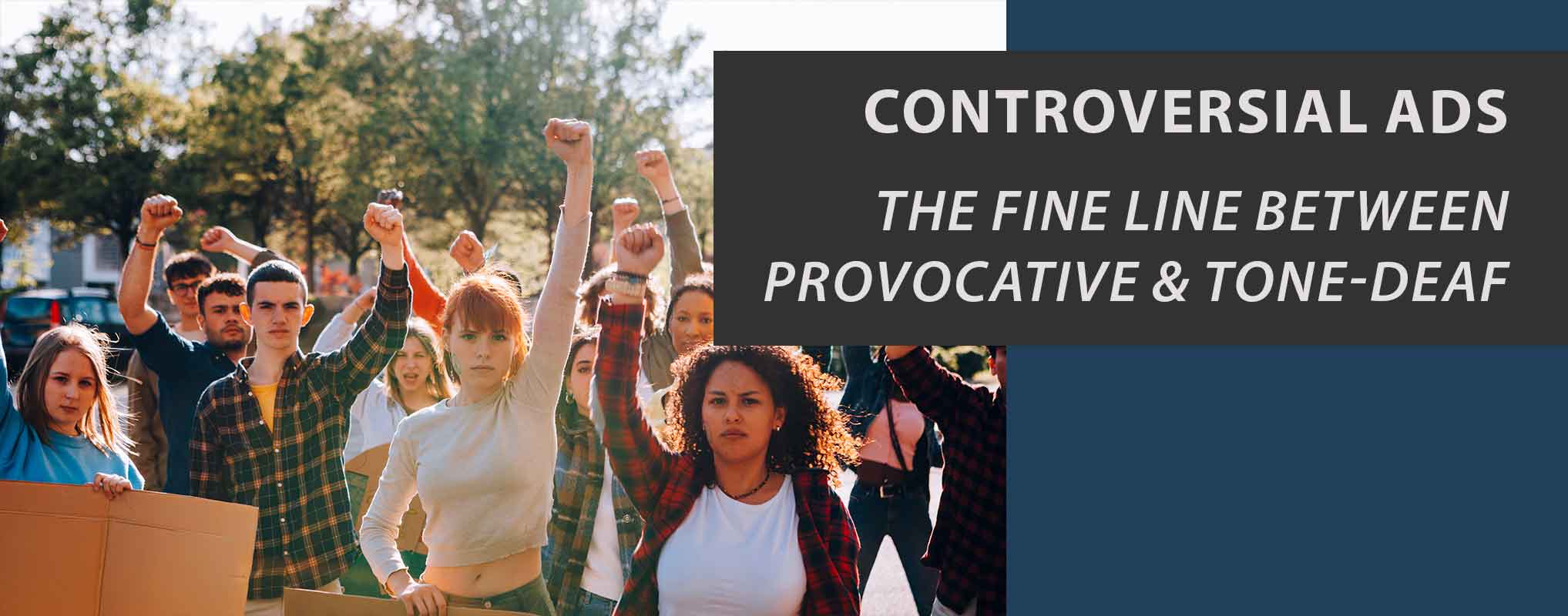
Frame by Frame
The Art and Science of Stellar Storytelling

By Jason Schuler on September 1, 2025

How can brands push boundaries without losing their audience?
Marketing has always been about finding the sharp edge between generating explosive sales growth and being caught on the outside of culture. From the earliest newspaper ads to the golden age of television commercials, brands have looked for ways to disrupt the ordinary. Some have done it with humor, others with spectacle, and some by stepping boldly into uncomfortable territory using controversial ads.
“There’s no such thing as bad publicity.”
It’s often attributed to 19th-century showman P. T. Barnum, though historians debate whether he actually said it. In marketing, the modern spin is usually:
“Any publicity is good publicity (as long as they spell your name right).”
The idea is that even negative attention can increase awareness, spark curiosity, and drive sales. But in reality, this only works if the attention aligns with the brand’s identity and values. Otherwise, it’s just self-inflicted damage with a spotlight on it.
That appetite for edge is nothing new, but the stakes are higher now. Modern marketing moves at the speed of social shares. Audiences are both more engaged and more critical than ever.
Don’t get me wrong, provocation is an intoxicating shortcut. It can make a brand the subject of headlines, dinner table conversations, and trending hashtags in a matter of hours. Sales can sky rocket. Domain ranking can multiply. And the right attention can grown a brand’s success overnight. The problem is that this whole thing is completely unpredictable. What feels like calculated risk during creative development can land as careless or offensive in the wild. In an age when everyone has a public platform, even a minor misstep can turn into a crisis.
Digital marketers know that attention is the first currency of persuasion. Provocative messaging commands attention in a way that polite, middle-of-the-road campaigns rarely do. A well-executed risk can tap into deep emotions, spark debate, and linger in the public mind long after a standard product spot has been forgotten. Think about the news cycle in 2025…the anger and frustration breed attention and trust.
But this approach is like playing with fire. In the right context it provides warmth and energy; in the wrong context it’s tyrannically destructive. Brands that win tend to have a clear internal alignment between their values, their audience, and their creative choices. Nike’s Dream Crazy aligned with its history of celebrating athletes who take risks. Pepsi’s Live for Now fizzled because it borrowed visual language from protest movements without authentic connection to the cause. The difference wasn’t the size of the gamble—it was whether the message belonged to the brand in the first place.
Another reason companies pursue edgy ideas is the multiplier effect. Earned media can exponentially increase the reach of a campaign. If people are talking about you in the news, on podcasts, and across social feeds, your media budget stretches further. The challenge is making sure that what they are saying reinforces your positioning rather than eroding it.

Emotion fuels memory. This is why people can still recall ads they saw years ago if those ads made them laugh, tear up, or feel a jolt of surprise. Research by the Institute of Practitioners in Advertising shows that campaigns with strong emotional content are twice as effective at driving profitability as those that rely solely on rational arguments. Another study from the University of Pennsylvania found that people are significantly more likely to share content that evokes high emotions, whether joy, awe, anger, or outrage.
Negativity and polarization have particular staying power. They keep people engaged, sometimes for reasons that have little to do with the subject matter itself. News channels have capitalized on this dynamic for decades, sustaining ratings through stories that split audiences into opposing camps. Advertising works in much the same way. People may not remember every product feature you list, but they will remember how your ad made them feel—especially if it pushed one of their emotional hot buttons.
The sweet spot is often described as the “benign violation” zone, where a message disrupts expectations without crossing into true offense. A clever twist in a familiar setting can engage the brain and create just enough tension to be memorable. Step too far past that invisible boundary, though, and you shift from stimulating interest to triggering defensive reactions. That’s when people stop talking about your message and start talking about what they think you did wrong.
Sometimes, the perception of offense is shaped more by timing and context than the content itself. An ad that might seem harmless in one cultural moment can ignite outrage in another. This is why even well-intentioned campaigns require acute awareness of the social and cultural climate before launch.
While bold creative gets attention, most marketing relies on subtler psychological levers. Understanding these levers helps explain why certain campaigns succeed without a hint of provocation. One of the most powerful is social proof—the idea that people are more likely to act when they see others doing the same. Testimonials, user-generated content, and influencer endorsements work because they tap into our instinct to follow perceived group consensus.
Another cornerstone is the scarcity principle. Limited-time offers, low-stock alerts, and exclusive releases create urgency, prompting quicker decisions. Brands also use reciprocity, giving value upfront in the form of free content, samples, or perks to trigger a natural desire to give something back, often in the form of a purchase.
Storytelling is the framework that ties these principles together. Humans are wired to process information in narrative form, which is why a well-told story can make a brand more relatable, a product more desirable, and a message more memorable. Even in campaigns with no hint of controversy, these fundamentals shape perception and drive action.
Nike’s Dream Crazy is a prime example of calculated risk paying off. By featuring Colin Kaepernick, Nike reinforced its image as a champion for those who challenge the status quo. The backlash from some quarters only strengthened the bond with its target audience. The surge in sales and market value was measurable proof that the alignment between brand, message, and audience was real.
Patagonia’s Don’t Buy This Jacket turned consumerism on its head at the peak of the holiday shopping season. The campaign urged people to think twice before buying—a radical position for a retailer. For Patagonia, it was a natural extension of its mission to reduce environmental impact. The resulting boost in sales demonstrated that a values-driven challenge can deepen trust while still driving revenue.
The Lawyer.com campaign starring Lindsay Lohan, produced by Awakened Films, proved that controversy is not the only way to create a cultural moment. By leaning into Lohan’s public persona with self-aware humor, the ad became a shareable hit without alienating anyone. The execution was tight, the message was clear, and the virality was no accident.
And watch a behind the scenes video of the campaign here:
Clearly you can create interesting and edgy content without needing to push the controversy button!
Controversial ads often share the same problem: they try to grab attention but misjudge public sentiment. These campaigns typically aim to provoke, spark conversation, or position the brand as bold and culturally relevant. Instead, they cross a line by trivializing sensitive issues, misrepresenting cultural movements, or failing to understand their audience.
Below we look at a list of high profile failures, each highlighting an important lesson for marketers: shock and virality are not enough. Without authentic alignment between the brand’s values, the cultural moment, and the audience’s expectations, controversy quickly turns into reputational damage.
American Eagle’s Sydney Sweeney “Great Jeans/Genes” campaign had all the makings of a hit—celebrity appeal, viral-ready visuals, and product scarcity—but stumbled into unintended controversy. A clever-sounding pun collided with imagery that some saw as coded messaging. Once that interpretation took hold, the brand’s explanations could not keep pace.
Pepsi’s Live for Now attempted to borrow the energy of protest movements and sell it alongside a can of soda. Without genuine connection to the causes depicted, the ad felt hollow and manipulative. The speed with which it was pulled reflected how badly it missed the mark.
H&M’s “Coolest Monkey in the Jungle” hoodie was another avoidable error. The product itself might have passed unnoticed, but placing it on a Black child model triggered an instant backlash rooted in the historical use of racist language. It sparked protests, store closures, and public apologies.
The Just For Feet Super Bowl ad featuring a Kenyan runner being drugged and forced into sneakers is an older but still relevant example. Intended as playful, it came across as neo-colonialist and deeply offensive. It was a costly lesson in why cultural literacy matters.
Celebrated for spotlighting everyday women, the campaign faced backlash when an ad appeared to show a Black woman turning white after using Dove body wash. This controversial ad prompted accusations of racism. Even authenticity can trip over its own feet if context shifts.
(Wikipedia)
HIV-positive tattoos, a Black woman nursing a White baby, dying AIDS patients….all of these elements wrestled with provoking empathy versus exploiting shock. Sometimes art. Sometimes tone-deaf. Always a lightning rod What do you think?
(Wikipedia)
A robot dreams it commits suicide when “fired.” The ad was pulled after mental health groups condemned it for trivializing suicide. When your metaphor becomes a trigger, the dream flips into a nightmare.
(Wikipedia)
From near-nude images to animals kneeling like Kaepernick, PETA Super Bowl pitches constantly get blocked for pushing protest imagery too far. Attention was definitely earned (but maybe at the expense of nuance).
(Wikipedia)
These adverts featuring emaciated models were ruled irresponsible. The ASA banned the images. Zara pulled the ads and doubled down on healthier representation. Sometimes restraint can be more radical than controversy.
(The Times)
The most important truth is that high-risk creative magnifies what is already present in a brand’s identity. If that identity is authentic and well-understood, a bold approach can strengthen it. If it is vague, opportunistic, or inconsistent, the same approach will expose the weaknesses.
Brands that succeed in this space commit to cultural literacy. They know the environments they are stepping into and respect the audiences they address. They prepare for multiple interpretations, not just the one they hope will land. They also ensure internal alignment so that when pushback comes, the organization stands behind the message instead of scrambling to disown it.
Clickbait is marketing’s equivalent of a shiny fishing lure—it’s engineered to get attention fast. The headline promises something irresistible, and the reader can’t help but bite. In its harmless form, clickbait is just curiosity well-packaged: think “You Won’t Believe What This Chef Uses Instead of Salt” or “The One Shoe Trend You’ll See Everywhere Next Month.” But when the headline overpromises and the content underdelivers, it breeds mistrust. That’s the long-term cost—short bursts of traffic that slowly erode your audience’s faith in your brand.
Ragebait is the more volatile cousin. It thrives on polarization, poking at moral outrage, cultural friction, or deeply held beliefs. Platforms reward it because the engagement is through the roof—angry comments, shares, and dueling threads all feed the algorithm. It’s why certain headlines or thumbnails seem designed to make you mutter under your breath before you even click. The trouble is, ragebait isn’t just risky for a brand’s reputation—it’s corrosive to trust. The short-term spike in attention can be followed by long-term alienation of entire audience segments.
The psychology here is straightforward: our brains are wired to prioritize threats and emotionally charged information. News outlets, influencers, and even major brands have used this to their advantage, sometimes intentionally, sometimes without realizing they’re stoking outrage. The takeaway for marketers? Curiosity is sustainable when paired with genuine value. Outrage is sustainable only for those willing to burn bridges. If you’re aiming for lasting relationships with your audience, build your hooks on intrigue and relevance—not on gasoline and matches.

So, How Do I Build a Bold (But Safe) Strategy
Any brand considering a provocative campaign should first map its permission space. This means identifying the topics, causes, and tones it can credibly engage with, based on history, mission, and audience expectations. From there, the goal is to operate in the zone between safe and reckless. Safe is forgettable; reckless is destructive.
Every campaign concept should be evaluated through three lenses. First, the audience lens: will your core customers feel included or alienated? Second, the cultural lens: is the broader environment primed to receive your message as intended? Third, the execution lens: will the core meaning survive if all context is stripped away?
Finally, brands should pre-test with a variety of audiences, plan for worst-case interpretations, and decide in advance how they will respond to criticism. When the campaign launches, it should start in spaces where the brand already has trust before expanding to broader markets.
The brands that survive and thrive after bold campaigns aren’t simply the ones that grab the biggest headlines. They are the ones that leave people with a story they are glad they heard, a feeling they want to revisit, or a belief they are proud to share. Controversy is only useful if it reinforces those things. If it is just noise, it is forgettable at best and reputation damaging at worst.
Think of every provocative idea as a magnifying glass. If your values and execution are sharp, the heat it generates will focus your message and ignite deeper loyalty. If they are weak or unfocused, that same magnifying glass will just burn holes where you cannot afford them. The difference is preparation, clarity, and the discipline to say no to ideas that are not truly yours to own.
In the end, marketing is a long game. The most powerful campaigns do not just win the news cycle. They earn trust, spark ongoing conversation, and keep the audience choosing you long after the hashtag has stopped trending. That is the kind of bold worth aiming for.
We’d love to help you with your next ad campaign!
Learn more about the types of advertisements that work here: https://awakenedfilms.com/types-of-advertisement/